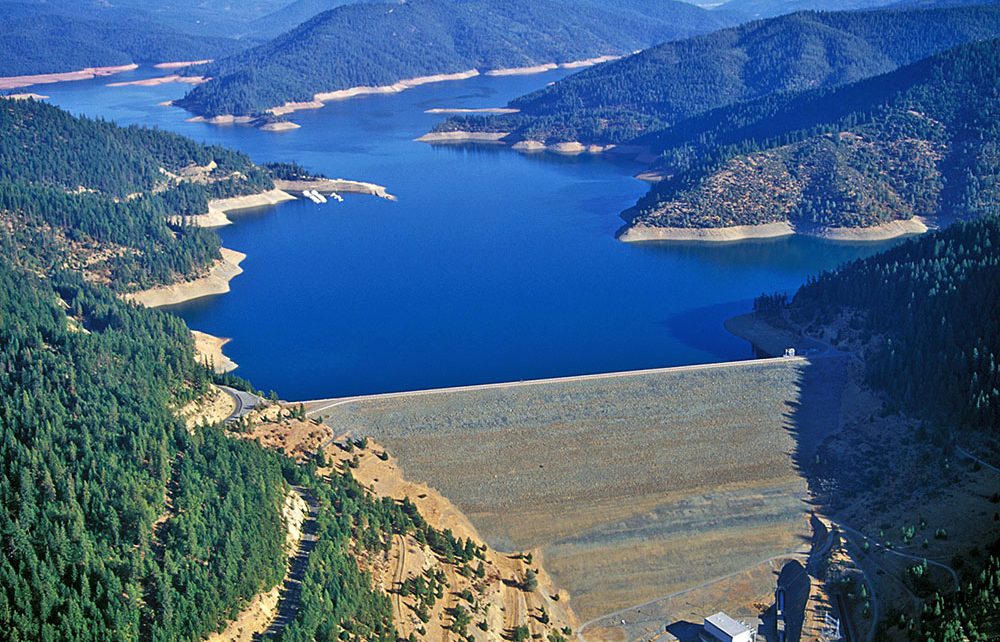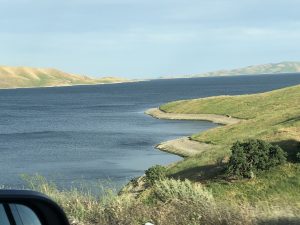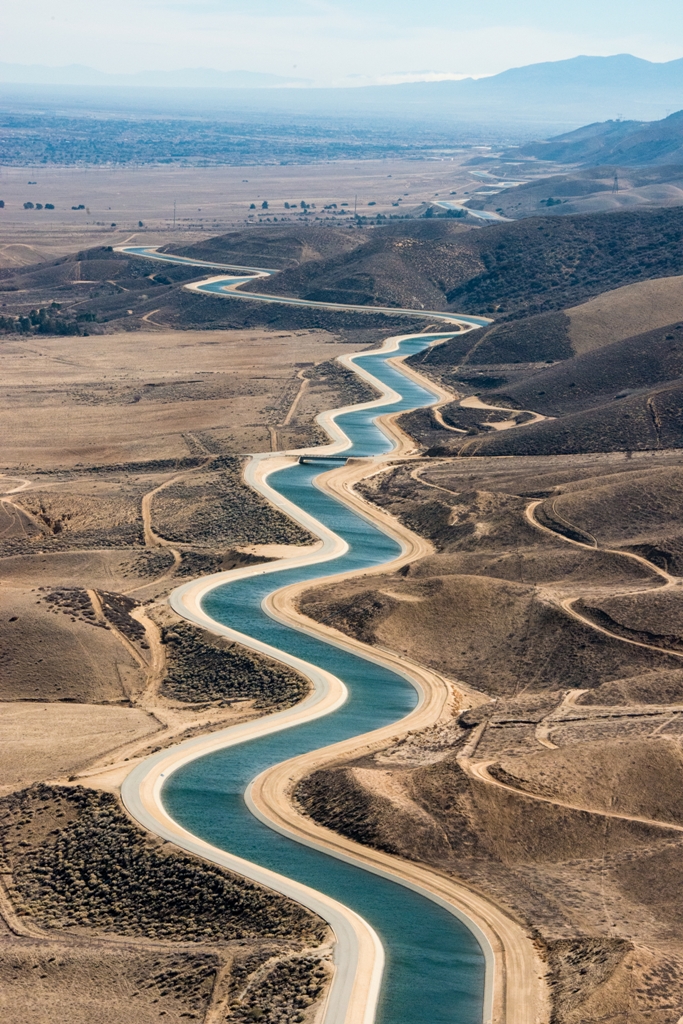
Trinity Dam Lake
Despite Double the Water Average in 2019, CA Imposing Water Rationing and Regulations
California’s Water Law: 55 gallons per person per day despite 200 percent snowpack
By Katy Grimes, May 23, 2019 9:00 am
California is abundant in natural resources: water, oil and natural gas, seafood, timber and minerals. Yet, the state has imposed water rationing on the state’s residents of 55 gallons per person, per day by 2020, is trying to pass legislation to prevent the petroleum industry from expanding, and has tried to outlaw fracking for natural gas. The once-thriving timber industry was successfully killed already, fishing and minerals are heavily regulated.
The winter of 2019 brought 200 percent of average rains and snow pack. Yet the state is still holding back on water to farmers, and residents will be rationed starting next year.
“South-of-Delta agricultural water service contractors’ allocations are increased to 70% of their contract total. South-of-Delta allocations for municipal and industrial contractors’ allocations are increased to 95% of their historic use,” the Bureau of Reclamation reported Wednesday.

“It is difficult to comprehend why the allocation remains below 100 percent,” the Westlands Water District said in a statement responding to the updated allocation, citing continued wet hydrologic conditions and above average Central Valley Project reservoir storage, the SV Sun reported. Westlands is the largest agricultural water district in the United States and provides water to 700 family-owned farms. It is comprised of more than 1,000 square miles of farmland in western Fresno and Kings Counties.
What Drought?
California’s last drought, five years long, ended in 2017. Rather than encourage lawmakers to bring him legislation to beef up the state’s water storage capacity, Gov. Jerry Brown signed new laws to limit each citizen to just 55 gallons per person per day by 2030, and 50 gallons by 2050.
And rather than require the State Water Resources Control Board to order the billions of dollars in water bonds actually be spent on safe drinking water, water storage, flood management, water recycling, drought preparedness, ecosystem and watershed protection and groundwater sustainability as they were approved, Brown chose to impose water rationing on the state’s homes and businesses. Yet urban water use is less than 10 percent of total water usage. The state allows approximately 50 percent to flow to the Pacific Ocean for fish populations; of the second 50 percent, 40 percent is used by agriculture, and 10 percent is for urban use. Rationing households will have no impact on water savings.
The 2019 snow pack recorded in early April was recorded at 106.5 inches of snow depth and a snow water equivalent of 51 inches, which is 200 percent of average.
“The 2019 water year will go down as one of the wettest years on record,” said Thomas Birmingham, Westlands’ general manager, in a statement. “Reclamation’s inability to provide south-of-Delta CVP water service contractors with full contract supplies is further evidence of the draconian impact ineffective regulations have had on water supplies for people. These regulations, theoretically intended to protect at-risk fish species, have strangled water supplies while continuously failing to provide effective protection for the species – all of which have continued to decline.”
Why are we rationing water?
SB 606 by Sen. Robert Hertzberg (D-Van Nuys) and AB 1668 by Assemblywoman Laura Friedman (D-Glendale), would grant the State Water Resources Control Board the authority to adopt a variety of enforceable water use standards, including standards for outdoor residential use and commercial, industrial, and institutional water use.
The bills also require cities, water districts, and large agricultural water districts to set strict annual water budgets. If they don’t meet these budgets, they face fines of $1,000 per day and $10,000 a day during droughts.
The state needs more water storage, and voters have passed bonds approving this. In 2014, the $100 million in the Prop 1 bond that had been earmarked for “Water Conservation (urban and agriculture)” was reallocated through two pieces of legislation to fund consumer rebates for urban landscape watering efficiency products. Agriculture irrigation conservation programs were left completely out of the equation. Prop 1 contained no other “agriculture” set-asides.
By 2018 when two more water bonds were on the ballot, the 2014 Proposition 1 water bond funding had not even been fully spent, and would not be spent by the end of 2018, according to the Public Policy Institute of California. Some hasn’t even been appropriated.
“The state’s 2014 bond, Proposition 1, provides $7.5 billion in funding,” the PPIC reported. “The money is broken into seven funding categories. The bond language preauthorized $2.7 billion for water storage projects.”
Proposition 84 and Prop 1E from 2006 still have money left, according to the PPIC. Given that the state still hasn’t spent that or additional sums from the $7.5 billion cache in the Proposition 1 water bond passed in 2014.
The state uses about 47.5 percent of its developed water supply for the environment, including wild river flows, managed wetlands and wildlife preserves, habitat and water quality control for fish, and required Delta outflows, according to the Department of Water Resource. Water is diverted in times of drought and times of plenty to the Sacramento-San Joaquin Delta, leaving much less for irrigation or for Californians to drink, residents will be limited to 55 gallons per day.







I’ll bet most people have forgotten that this maddening thing is on the books and coming soon.
It’s really beyond belief that we should have to watch our p’s and q’s in our daily lives under the jackboot of these tin god hypocrites when we have a million things going on which are none of their damn business.
It’s really just an excuse to raise water rates beyond affordability and, oh yeah, bonus points for the thrill they apparently get from controlling other people’s lives.
I lived in California for 60 years. Drought comes and goes, but is getting more prevalent with increased population and agriculture needs. People forget that most of the state is a desert and aquifers have been depleted. Conservation needs to become a habit.
Actually, droughts are not more prevalent. California’s drought conditions are actually historically normal, California’s most recent drought was billed by government and media as the driest period in the state’s recorded rainfall history. Scientists who study the Western United States’ long-term climate patterns say California has been dry for significantly longer periods — more than 200 years.
The actual issues is that very little has been spent at all for water storage projects that would create new water-supply sources for Californians, which is what the state actually needs in order to realistically deal with inevitable droughts.
The state of California hasn’t significantly invested in water storage since the 1970s when Jerry Brown was governor the first time around. “This is an era of limits and we all had better get used to it,” Brown said upon being elected governor in 1975, embracing the “small is beautiful” way of thinking. Since then, California’s population has doubled, as have environmental demands.
New Dams/reservoirs need to be build and existing dams need to be built up. This is a political problem – not a water problem.
Dead on! This is the result of nearly 50 years of criminal negligence by California legislators. It’s part of the bigger crumbling infrastructure that is a disgraceful embarrassment.
Stop dumping water into the ocean. Stop every home in California
From watering the streets and sidewalks, a directive to business’s to plant shrubs and other foliage that doesn’t take much water.
Maybe we would have enough water for residential use without all this rationing.
Building infrastructure needs to become a habit.
Sorry, Katy, but anyone who thinks Trump is a fine president does not meet my definition of credible.
Here’s why, Katy, you are not credible.
https://finance.yahoo.com/news/correct-information-california-water-efficiency-222625943.html
I have a property with 40 fruit trees. We use much more than 55 gallons per person in our household in the summer. But in the winter during rainy moths, when we are not watering our grove, we use about 55 to 60 gallons per person per day inside the house, and we tend to love looooong showers. Getting to 50 would not be difficult or a hardship. I suspect most people will be close to this for indoor water use. If the standard you refer to included our grove, it would be a concern. It doesn”t, and it isn’t. And the reg and fine doesn’t apply to individuals anyway.
So stop the right wing propaganda. The sky isn’t falling.
When your usage fee triples then you’ll be looking into drilling a well ., Do you not know that millions of gallons of water is dumped in the pacific each week or so .. You need to know every living thing needs water – your grove is the only thing you water outdoors doubt it .. Or are you one of those buddies to a water district that gets extra favors for being a good ole boy?
When your usage fees triples then you’ll be looking into drilling a well .. Get your head out of the sand Do you not know that millions of gallons of water is dumped in the pacific each week or so .. You need to know every living thing needs water – your grove is the only thing you water outdoors, doubt it .Dogs? Cats? Grandchildren? . Or are you one of those buddies to a water district that gets extra favors for being a good ole boy?